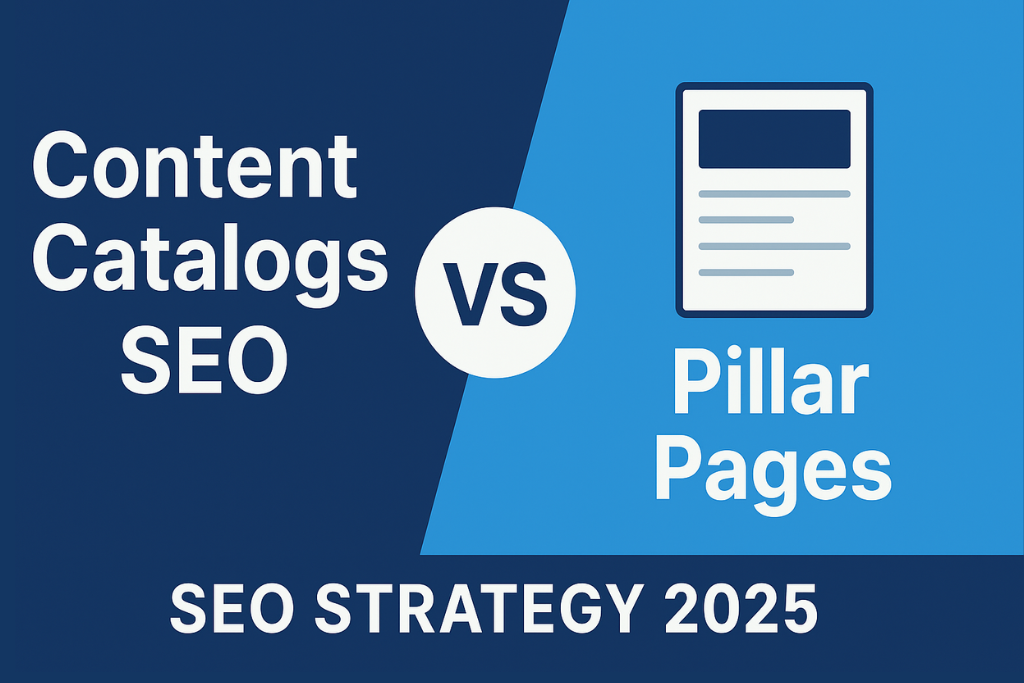Content Catalogs vs Pillar Pages: Strategic Architecture for SEO in 2025

Search engine optimization has entered a new era. With AI-driven answer engines like ChatGPT, Gemini, and Perplexity reshaping how users consume information, businesses must rethink their content strategy. Two powerful approaches dominate SEO discussions in 2025: Content Catalogs vs Pillar Pages.
While both models aim to organize content effectively, their execution and impact on search rankings differ. Choosing the right architecture could mean the difference between dominating Google’s SERPs or getting buried under AI summaries.
In this guide, we’ll compare Content Catalogs vs Pillar Pages, explore their strengths, weaknesses, and strategic applications, and reveal how to future-proof your content architecture for maximum SEO performance.
What Are Content Catalogs?
A Content Catalog is a centralized hub that organizes your digital assets in a structured, thematic manner. Think of it as a searchable library that categorizes every piece of content—blogs, videos, case studies, infographics, and guides—under broad strategic topics.
Key Characteristics of Content Catalogs
-
Comprehensive Indexing: Every resource is listed for quick accessibility.
-
User Experience Focused: Simplifies navigation for both search engines and users.
-
Topic Clustering: Organizes content around categories, subtopics, and formats.
-
Scalable: Easily accommodates future content without breaking structure.
Benefits of Content Catalogs for SEO
-
Enhanced Crawlability: Search engines can quickly discover and index all assets.
-
Keyword Coverage: Catalog pages target multiple keyword clusters at once.
-
Improved User Retention: Visitors find content easily, reducing bounce rates.
-
Content Visibility: Strong chance of ranking for long-tail and semantic search queries.
Example: A SaaS company might build a Content Catalog on “Digital Marketing Resources,” listing blogs, eBooks, and webinars under categories like SEO, Paid Ads, and Automation.
What Are Pillar Pages?
A Pillar Page is an in-depth, authoritative content piece that covers a broad topic comprehensively and links to supporting cluster pages. It acts as the foundation of a Topic Cluster Model, ensuring both depth and breadth of coverage.
Key Characteristics of Pillar Pages
-
Long-Form Format: Usually 3,000–5,000 words with comprehensive coverage.
-
Internal Linking Hub: Links to multiple related cluster articles.
-
Keyword Authority: Built around a single core keyword or phrase.
-
Evergreen Nature: Updated regularly to maintain authority.
Benefits of Pillar Pages for SEO
-
Topical Authority: Boosts credibility by fully covering a core subject.
-
Improved Rankings: Search engines reward depth, structure, and internal linking.
-
Link Building Magnet: High-quality, comprehensive pages attract backlinks.
-
Better User Journey: Readers explore related subtopics seamlessly.
Example: A digital agency could create a Pillar Page on “Search Engine Optimization,” linking to cluster articles on on-page SEO, backlinks, and technical SEO.
Content Catalogs vs Pillar Pages: Key Differences
| Feature | Content Catalogs | Pillar Pages |
|---|---|---|
| Purpose | Organize all content | Deep dive into one broad topic |
| Format | Directory-style, structured | Long-form, narrative-driven |
| SEO Impact | Indexing & keyword clustering | Authority & topical dominance |
| User Experience | Easy navigation & search | In-depth education & linking |
| Scalability | Highly scalable | Requires frequent updates |
Why Content Catalogs vs Pillar Pages Matters in 2025
In 2025, Google’s Search Generative Experience (SGE) and AI-powered assistants prioritize well-structured, authoritative content. The battle between Content Catalogs vs Pillar Pages isn’t about which one is “better,” but rather about strategic alignment with user intent.
-
Content Catalogs excel for industries producing large, diverse content assets.
-
Pillar Pages dominate when depth, topical expertise, and authority are essential.
Brands that combine both approaches achieve maximum SERP visibility, user retention, and AI discoverability.
Building a Content Catalog for SEO in 2025
To leverage a content catalog effectively, follow these steps:
1. Audit Existing Content
Map all current assets across categories, ensuring no duplicate or thin content remains.
2. Define Content Categories
Choose broad, evergreen themes aligned with audience intent (e.g., SEO, AI Marketing, E-commerce).
3. Optimize for Keywords
Assign keyword clusters to each category page and interlink supporting resources.
4. Enhance User Navigation
Incorporate filters, search bars, and logical hierarchy for smooth user experience.
5. Update Continuously
As new resources are published, update the catalog to maintain freshness.
Pro Tip: Use schema markup for catalogs to increase rich snippet visibility.
Building a Pillar Page for SEO in 2025
Pillar pages remain a cornerstone of topical authority. Here’s how to build one:
1. Select a Core Topic
Choose a broad subject with high search volume and long-term relevance.
2. Create Comprehensive Content
Cover every angle—history, best practices, FAQs, trends, and case studies.
3. Link to Cluster Content
Connect supporting articles with keyword-rich anchor texts.
4. Optimize On-Page SEO
-
Use H2s with variations of the focus keyphrase.
-
Add internal/external links.
-
Optimize for featured snippets and “People Also Ask.”
5. Update Regularly
Refresh stats, strategies, and links every 3–6 months to maintain ranking.
Content Catalogs vs Pillar Pages: Which One Should You Choose?
The choice between Content Catalogs vs Pillar Pages depends on your goals:
-
Choose Content Catalogs if:
-
You produce a wide variety of assets.
-
You want a library-style hub for easy discovery.
-
Your audience prefers quick navigation.
-
-
Choose Pillar Pages if:
-
You need to establish topical authority.
-
You target high-competition keywords.
-
You aim to become an industry thought leader.
-
Best Practice for 2025: Use both architectures together. Build Pillar Pages for depth and authority, and organize them under Content Catalogs for accessibility and SEO scalability.
Future of SEO: AI and Content Architecture
With AI shaping search results, future-proof SEO means building content architectures that serve both human readers and machine learning models.
-
Content Catalogs help AI engines fetch relevant, organized resources.
-
Pillar Pages ensure AI recognizes topical expertise and authority.
-
Together, they increase chances of being featured in AI-driven answers and Google’s SGE.
Content Catalogs vs Pillar Pages for SEO Success
The debate between Content Catalogs vs Pillar Pages in 2025 isn’t about choosing one over the other—it’s about strategic synergy.
-
Use Content Catalogs to organize your resources, improve discoverability, and serve user navigation.
-
Use Pillar Pages to establish authority, dominate keyword rankings, and attract backlinks.
-
Combine both for maximum impact in the evolving SEO landscape.
By aligning these strategies, your brand won’t just survive the AI-driven search evolution—it will thrive.
